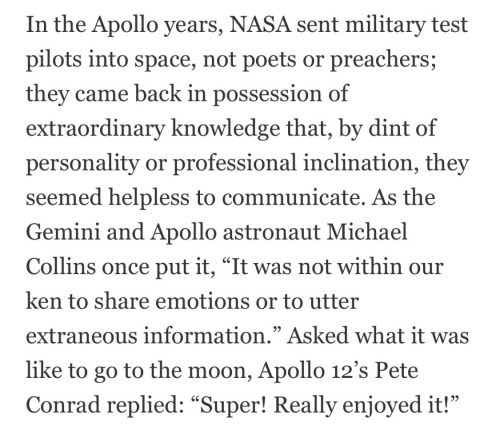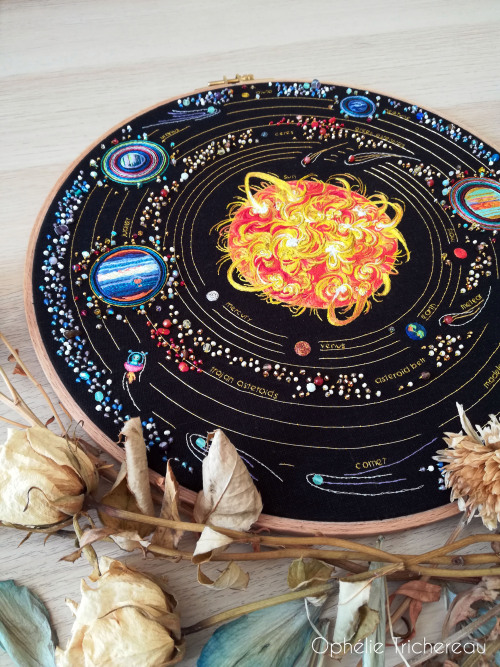Crab Nebula

Crab Nebula
More Posts from Ad-astra-affecte-spe and Others

The monsters that live on the Sun are not like us. They are larger than the Earth and made of gas hotter than in any teapot. They have no eyes, but at times, many tentacles. They float. Usually, they slowly change shape and just fade back onto the Sun over about a month. Sometimes, though, they suddenly explode and unleash energetic particles into the Solar System that can attack the Earth. Pictured is a huge solar prominence imaged almost two weeks ago in the light of hydrogen. Captured by a small telescope in Gilbert, Arizona, USA, the monsteresque plume of gas was held aloft by the ever-present but ever-changing magnetic field near the surface of the Sun. Our active Sun continues to show an unusually high number of prominences, filaments, sunspots, and large active regions as solar maximum approaches in 2025.

Bubble Nebula and the Star Cluster

The original Voyager 1 "Blue Movie" which records its approach during a period of over 60 Jupiter days (January 6 - February 3, 1979)


Lunar halo
@picabuzz

Perseverance: Drifting clouds just before sunrise on Mars (March 18, 2023)




SPACEMAS DAY 2 ✨🪐🌎☄️☀️🌕
There's a new space telescope in the sky: Euclid. Equipped with two large panoramic cameras, Euclid captures light from the visible all the way to the near-infrared. It took five hours of observing for Euclid's 1.2-meter diameter primary mirror to capture, the 1000+ galaxies in the Perseus cluster which lies 250 million light years away. More than 100,000 galaxies are visible in the background, some as far away as 10 billion light years. Euclid's initial surveys, covering a third of the sky and recording over 2 billion galaxies, will enable a study of how dark matter and dark energy have shaped our universe.
Image Credit: ESA, NASA
-
 fad1d reblogged this · 3 weeks ago
fad1d reblogged this · 3 weeks ago -
 whiteswam liked this · 2 months ago
whiteswam liked this · 2 months ago -
 andromedalone reblogged this · 5 months ago
andromedalone reblogged this · 5 months ago -
 andromedalone liked this · 5 months ago
andromedalone liked this · 5 months ago -
 lackagold liked this · 9 months ago
lackagold liked this · 9 months ago -
 rocket-man-major-tom reblogged this · 9 months ago
rocket-man-major-tom reblogged this · 9 months ago -
 rocket-man-major-tom liked this · 9 months ago
rocket-man-major-tom liked this · 9 months ago -
 vesselsbliss liked this · 9 months ago
vesselsbliss liked this · 9 months ago -
 welcometomyislandbitch reblogged this · 1 year ago
welcometomyislandbitch reblogged this · 1 year ago -
 braveulyses liked this · 1 year ago
braveulyses liked this · 1 year ago -
 ashleighxcx reblogged this · 1 year ago
ashleighxcx reblogged this · 1 year ago -
 ashleighxcx liked this · 1 year ago
ashleighxcx liked this · 1 year ago -
 passionwolf liked this · 1 year ago
passionwolf liked this · 1 year ago -
 aussieflamecriterion liked this · 1 year ago
aussieflamecriterion liked this · 1 year ago -
 fdelopera liked this · 1 year ago
fdelopera liked this · 1 year ago -
 objectum-yuri reblogged this · 1 year ago
objectum-yuri reblogged this · 1 year ago -
 vegapunk123 liked this · 1 year ago
vegapunk123 liked this · 1 year ago -
 theghostofchambersroad liked this · 1 year ago
theghostofchambersroad liked this · 1 year ago -
 weedswrites reblogged this · 1 year ago
weedswrites reblogged this · 1 year ago -
 wholissaa liked this · 1 year ago
wholissaa liked this · 1 year ago -
 extinctavialae liked this · 1 year ago
extinctavialae liked this · 1 year ago -
 platinumalldayeveryday liked this · 1 year ago
platinumalldayeveryday liked this · 1 year ago -
 kz900dohc liked this · 1 year ago
kz900dohc liked this · 1 year ago -
 mskristiana liked this · 1 year ago
mskristiana liked this · 1 year ago -
 trippydip liked this · 1 year ago
trippydip liked this · 1 year ago -
 mishcho liked this · 1 year ago
mishcho liked this · 1 year ago -
 jqhsuxuwbjwiwshhwjwuzyzyyxyd liked this · 1 year ago
jqhsuxuwbjwiwshhwjwuzyzyyxyd liked this · 1 year ago -
 topperpro2800 liked this · 1 year ago
topperpro2800 liked this · 1 year ago -
 xploseof reblogged this · 1 year ago
xploseof reblogged this · 1 year ago -
 njfishsposts liked this · 1 year ago
njfishsposts liked this · 1 year ago -
 tomato197610 liked this · 1 year ago
tomato197610 liked this · 1 year ago -
 thestarlightpaladin reblogged this · 1 year ago
thestarlightpaladin reblogged this · 1 year ago -
 dagothnik reblogged this · 1 year ago
dagothnik reblogged this · 1 year ago -
 dagothnik liked this · 1 year ago
dagothnik liked this · 1 year ago -
 shannybangbang liked this · 1 year ago
shannybangbang liked this · 1 year ago -
 l1lyeggu liked this · 1 year ago
l1lyeggu liked this · 1 year ago -
 shannybangbang reblogged this · 1 year ago
shannybangbang reblogged this · 1 year ago -
 carn1v0r0us reblogged this · 1 year ago
carn1v0r0us reblogged this · 1 year ago -
 chuck-silva liked this · 1 year ago
chuck-silva liked this · 1 year ago -
 moonstalice reblogged this · 1 year ago
moonstalice reblogged this · 1 year ago

★•Astronomy, Physics, and Aerospace•★ Original and Reblogged Content curated by a NASA Solar System Ambassador
204 posts











